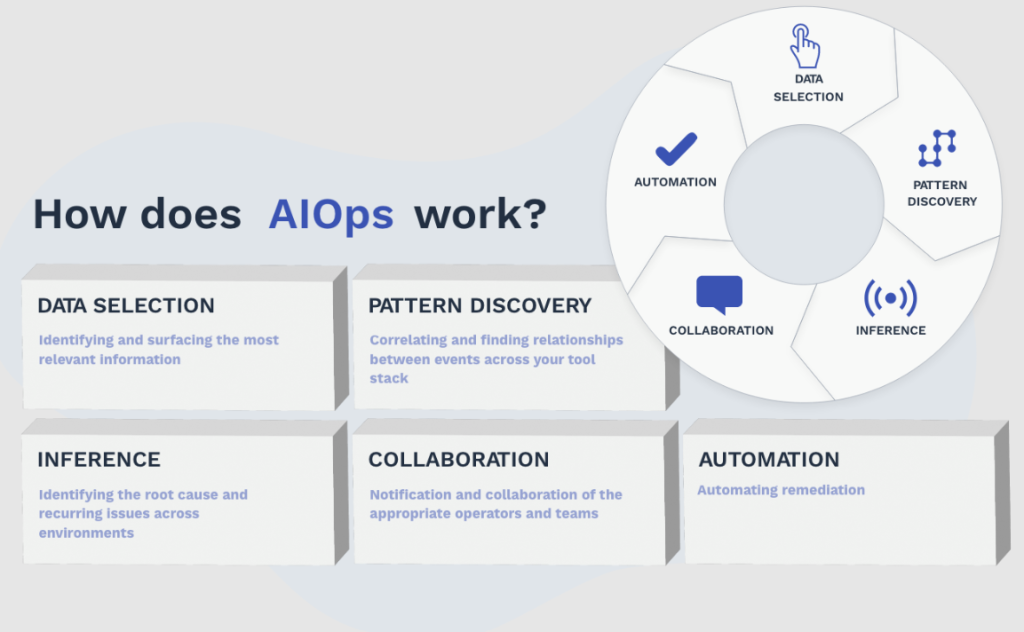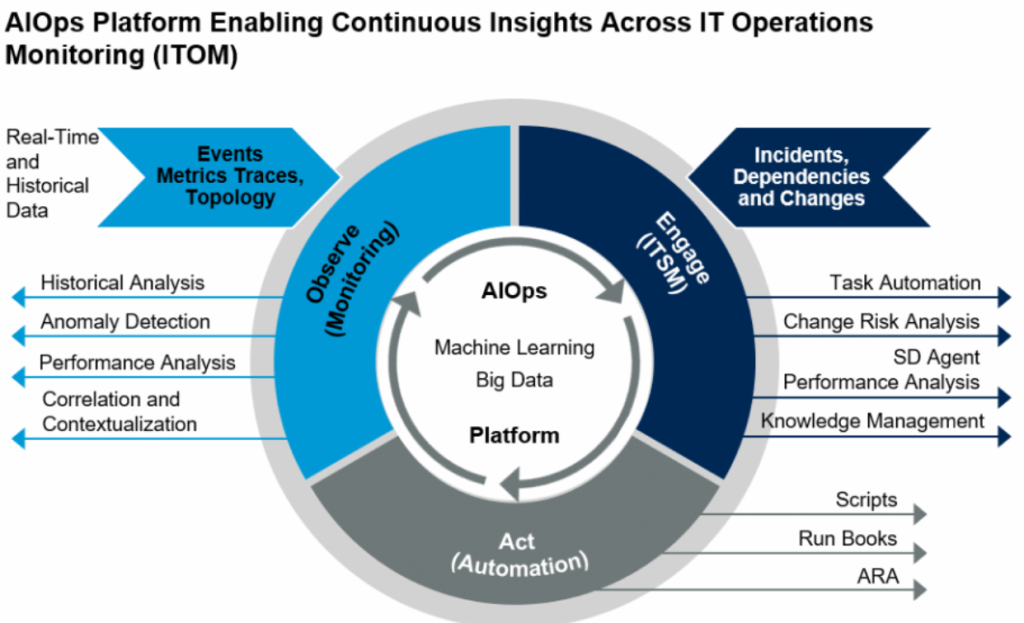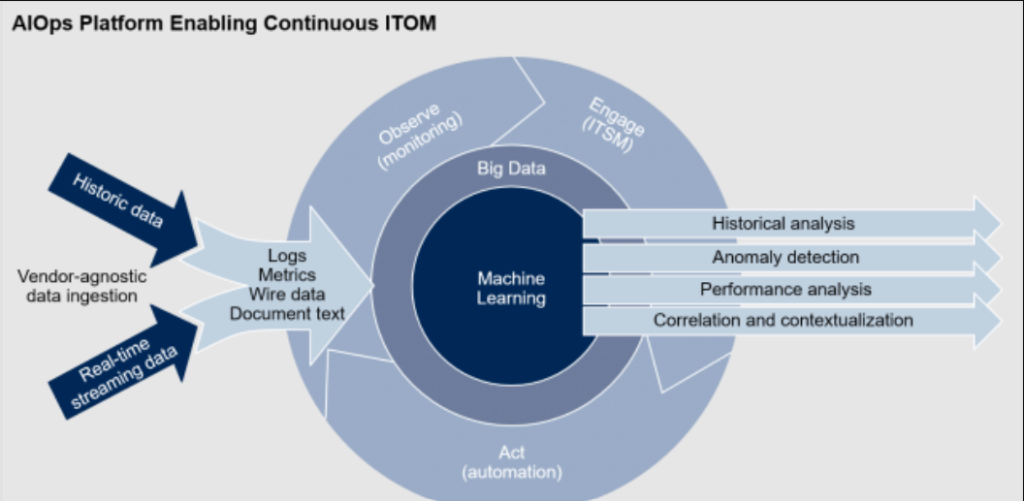
AIOps (Artificial Intelligence for IT Operations) works by leveraging advanced technologies such as artificial intelligence (AI), machine learning (ML), big data analytics, and automation to enhance and streamline various aspects of IT operations. Here’s an overview of how AIOps works:
- Data Collection: AIOps begins by collecting data from a wide range of sources within an IT environment. This can include data from servers, applications, network devices, logs, metrics, monitoring tools, and more. The data is often collected in real-time or near-real-time.
- Data Ingestion: The collected data is ingested into a centralized platform or system that can handle and process large volumes of data. This platform serves as the foundation for AIOps operations.
- Data Correlation and Analysis:
- Pattern Recognition: AIOps uses machine learning algorithms to analyze the collected data and identify patterns, trends, and anomalies. These patterns can include regular behavior as well as deviations from the norm.
- Correlation: The system correlates data from different sources to identify relationships between events. For example, it might detect that a spike in network traffic is correlated with increased application latency.
- Incident Detection and Prediction:
- Anomaly Detection: AIOps identifies anomalies that indicate potential issues or disruptions. These anomalies can range from sudden changes in system behavior to deviations in performance metrics.
- Predictive Analysis: By analyzing historical data and patterns, AIOps can predict potential incidents before they occur. For instance, it might predict a potential server overload based on historical usage patterns.
- Root Cause Analysis: When an incident occurs, AIOps helps identify the root cause by analyzing the correlated data and pinpointing the event or combination of events that led to the problem.
- Automated Remediation: AIOps can automate responses to certain incidents or issues. For known and well-defined problems, the system can execute predefined automated actions to resolve the issue without human intervention. This can include restarting services, reallocating resources, or triggering failovers.
- Human Collaboration: AIOps tools often provide a user interface that IT teams can use to investigate incidents, validate recommendations, and make decisions. Human expertise is still crucial for handling complex and unique situations.
- Continuous Learning: AIOps systems continuously learn from new data and feedback. Over time, the system becomes more accurate in identifying patterns and predicting outcomes.
- Performance Optimization: AIOps helps optimize resource allocation and capacity planning by analyzing usage patterns and making recommendations for efficient resource utilization.

By automating routine tasks, detecting issues early, and providing actionable insights, AIOps enables IT teams to proactively manage their IT environments, reduce downtime, and improve overall operational efficiency.
AIOps works by collecting data from a variety of sources, such as monitoring tools, ticketing systems, and event logs. It then uses this data to build models that can identify patterns and anomalies. These models can be used to predict future problems, automate tasks, and improve decision-making.Here are the key steps involved in AIOps:
- Data collection: AIOps solutions collect data from a variety of sources, such as monitoring tools, ticketing systems, and event logs. This data can be structured or unstructured, and it can be from a variety of different formats.
- Data preparation: The data collected by AIOps solutions needs to be prepared before it can be used to build models. This involves cleaning the data, removing outliers, and normalizing the data.
- Modeling: AIOps solutions use machine learning algorithms to build models that can identify patterns and anomalies in the data. These models are typically trained on historical data, and they can be used to predict future problems, automate tasks, and improve decision-making.
- Deployment: Once the models are built, they need to be deployed in production. This involves integrating the models with the IT operations tools and processes.
- Monitoring: The performance of AIOps solutions needs to be monitored to ensure that they are working as expected. This involves monitoring the accuracy of the models, the performance of the algorithms, and the impact of AIOps on IT operations.
AIOps is a complex and constantly evolving technology. There are a number of different ways to implement AIOps, and the best approach will vary depending on the specific needs of the organization.Here are some of the benefits of AIOps:
- Improved efficiency: AIOps can help to improve the efficiency of IT operations by automating tasks, such as anomaly detection and root cause analysis. This can free up IT staff to focus on more strategic initiatives.
- Reduced costs: AIOps can help to reduce costs by identifying and eliminating waste. For example, AIOps can be used to optimize the use of IT resources, such as servers and storage.
- Improved performance: AIOps can help to improve the performance of IT systems by identifying and resolving problems early. This can help to prevent outages and performance degradation.
- Improved decision-making: AIOps can help to improve decision-making by providing insights into IT operations data. This can help IT leaders to make better decisions about resource allocation, capacity planning, and incident response.

AIOps is a powerful tool that can help organizations improve their IT operations. However, it is important to note that AIOps is not a silver bullet. It is still a relatively new technology, and there are challenges associated with its implementation.Some of the challenges of AIOps include:
- Data quality: The quality of the data used by AIOps solutions is critical to their success. If the data is not accurate or complete, the models built by AIOps solutions will be inaccurate.
- Complexity: AIOps solutions can be complex to implement and manage. This is because they typically involve a lot of different data sources, algorithms, and models.
- Security and privacy: AIOps solutions can collect a lot of sensitive data about IT systems and operations. This data needs to be protected from unauthorized access and disclosure.

